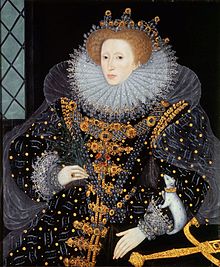Cultural depictions of weasels
Different species of weasel have lived alongside humans on every continent except Antarctica and Australia, and have been assigned a wide range of folkloric and mythical meanings.
Excavations in Çatalhöyük, the earliest known agricultural settlement in Turkey (dating to 7000-6000 BC), uncovered animal parts which were incorporated into the structure of homes in what may have been a ritual practice.
The version in which the yōkai appears as a weasel describes it as having the bristles of a hedgehog, cry of a dog, and sickles for limbs.
[8] The ermine was seen as a symbol of purity, for the belief that it would rather die than dirty its white fur: if hunters were chasing it, it would supposedly turn around and surrender rather than risk soiling itself.
[9] Because of this association, ermine fur had been used in heraldry, as a trim on crowns and coronation cloaks, and on the garments of prelates of the Catholic Church for hundreds of years.
[20] Weasels, ferrets, and stoats appear in Kenneth Grahame's The Wind in the Willows as the antagonists for the book's third act after they invade and take over Toad Hall.
In Brian Jacques' Redwall series of books, weasels are depicted as villainous (and deceitful in particular), living in and leading groups of other carnivorous mammals, such as ferrets, rats, and foxes.
[21][22][23][24][25][26] In 1851, in chapter 133 of the first American edition of Herman Melville's eponymously titled novel Moby-Dick, the white-speckled whale dives deep.
In 2006, musical comedian Weird Al Yankovic wrote a satirical song, "Weasel Stomping Day".
It depicts a bizarre holiday in which people apparently wear Viking helmets, spread mayonnaise on their lawns, and literally go out "stomping" weasels.
An actual play show, the plot revolved a family of Stoats who have gained human level sapience in the fallout of a nuclear reactor meltdown.



